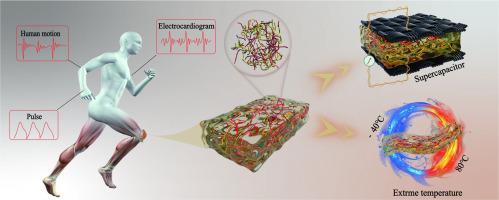Hoffmeister效应使双网络纤维素水凝胶电解质具有极高的环境稳定性和增强的导电性,可用于可穿戴设备和应变传感器
IF 14.3
1区 材料科学
Q1 MATERIALS SCIENCE, MULTIDISCIPLINARY
引用次数: 0
摘要
理想的柔性传感器应具有优异的机械性能、优异的电化学性能和高的环境耐受性,以确保在可穿戴电子产品中的长期适用性。然而,集成这些多功能属性仍然是一个主要挑战。受人体皮肤组织的启发,本研究通过盐析辅助的氢键重组策略开发了一种具有分层网络的聚丙烯酸-TA@CNF (PTCCG-Na⁺)水凝胶。单宁酸包封的纤维素纳米纤维(TA@CNF)含有刚性结晶区和丰富的氢键位点,可与甘油和聚丙烯酸(PAA)相互作用形成动态氢键网络。这种结构使水凝胶具有优异的拉伸性能(>;1300%),长期循环稳定性(>;2000个循环),以及广泛的环境适应性(- 40至80°C)。此外,NaCl和碳纳米管(CNTs)作为物理增强剂,提供额外的物理交联并协同提高水凝胶的电导率(72.88 mS cm−1)。这些综合功能使水凝胶可以应用于心率和脉搏监测的可穿戴传感器,以及超级电容器(电容:422.545 mF cm−2,0.83 mA cm−2)。本研究提出了一种开发具有稳定机械性能、优异环境耐受性和高导电性的水凝胶的新策略。本文章由计算机程序翻译,如有差异,请以英文原文为准。

Hoffmeister effect assisted the double-network cellulose hydrogel electrolyte with extreme environmental stability and enhanced conductivity for wearable devices and strain sensors
An ideal flexible sensor should possess excellent mechanical properties, outstanding electrochemical performance, and high environmental tolerance to ensure long-term applicability in wearable electronics. However, integrating these multifunctional properties remains a major challenge. Inspired by human skin tissue, this study develops a poly (acrylic acid)-TA@CNF (PTCCG-Na⁺) hydrogel with a hierarchical network via a hydrogen bond recombination strategy assisted by salting-out. The tannic acid-encapsulated cellulose nanofibers (TA@CNF), containing rigid crystalline regions and abundant hydrogen bonding sites, interact with glycerol and poly (acrylic acid) (PAA) to form a dynamic hydrogen bond network. This structure imparts the hydrogel with remarkable tensile performance (> 1300%), long-term cycling stability (> 2000 cycles), and broad environmental adaptability (−40 to 80°C). Additionally, NaCl and carbon nanotubes (CNTs) serve as physical reinforcement agents, providing additional physical crosslinking and synergistically enhancing the electrical conductivity (72.88 mS cm−1) of the hydrogel. These combined features allow the hydrogel to be applied in wearable sensors for heart rate and pulse monitoring, as well as in supercapacitors (capacitance: 422.545 mF cm−2 at 0.83 mA cm−2). This study presents a novel strategy for developing hydrogels with stable mechanical properties, exceptional environmental tolerance, and high conductivity.
求助全文
通过发布文献求助,成功后即可免费获取论文全文。
去求助
来源期刊

Journal of Materials Science & Technology
工程技术-材料科学:综合
CiteScore
20.00
自引率
11.00%
发文量
995
审稿时长
13 days
期刊介绍:
Journal of Materials Science & Technology strives to promote global collaboration in the field of materials science and technology. It primarily publishes original research papers, invited review articles, letters, research notes, and summaries of scientific achievements. The journal covers a wide range of materials science and technology topics, including metallic materials, inorganic nonmetallic materials, and composite materials.
 求助内容:
求助内容: 应助结果提醒方式:
应助结果提醒方式:


